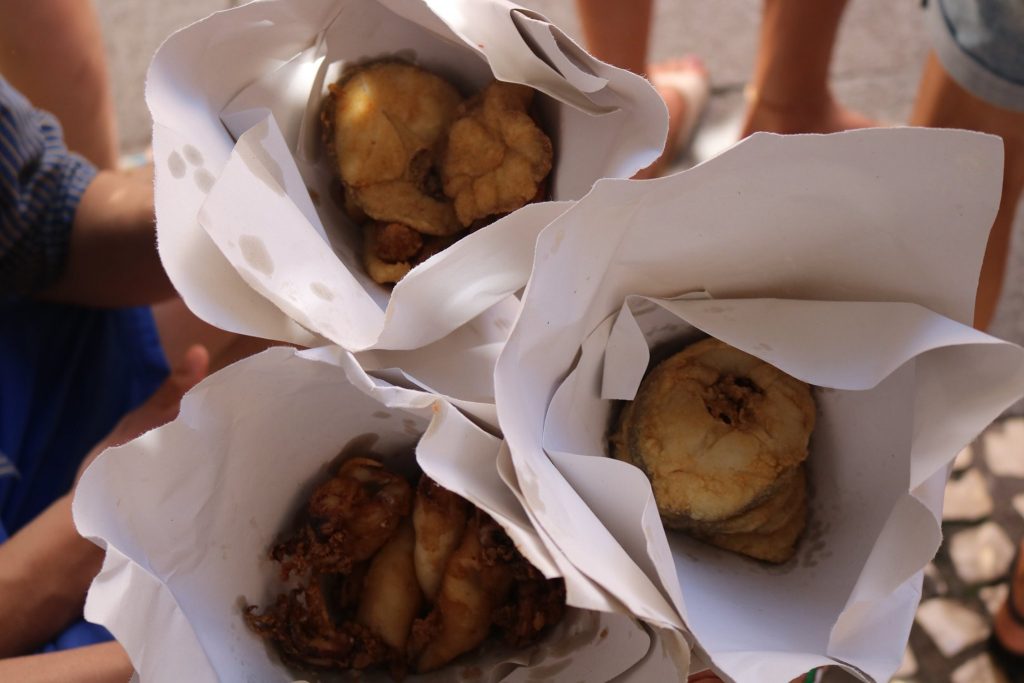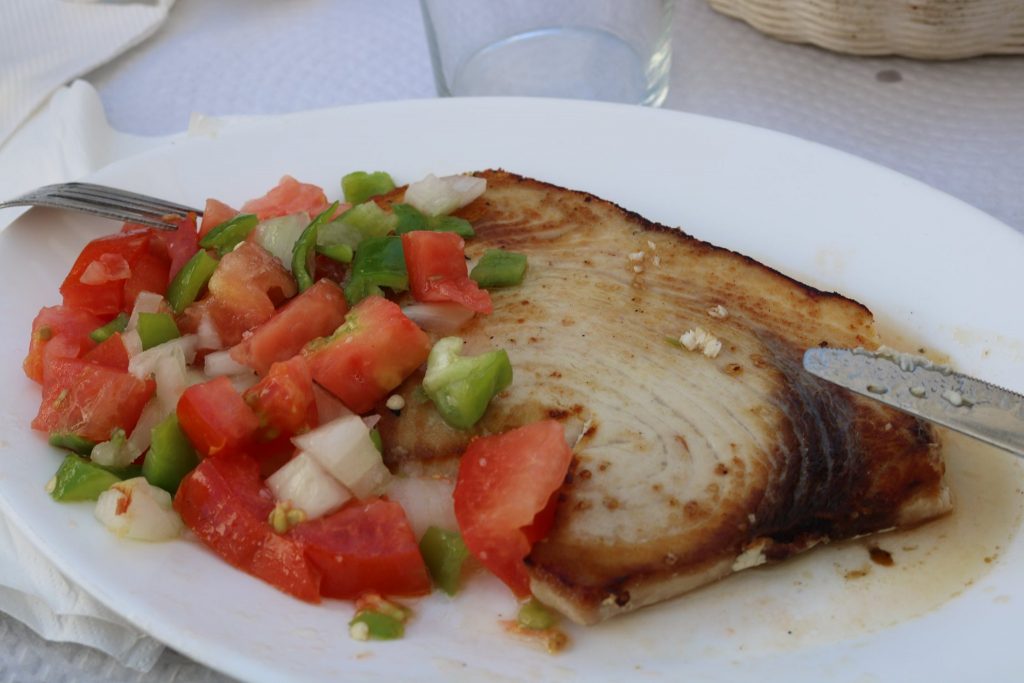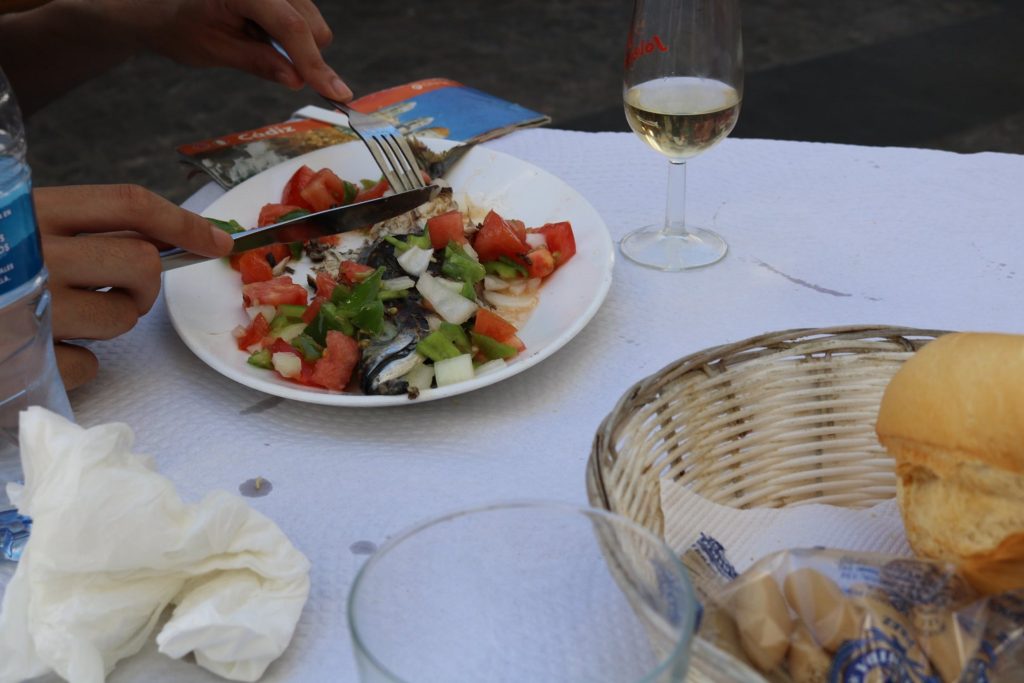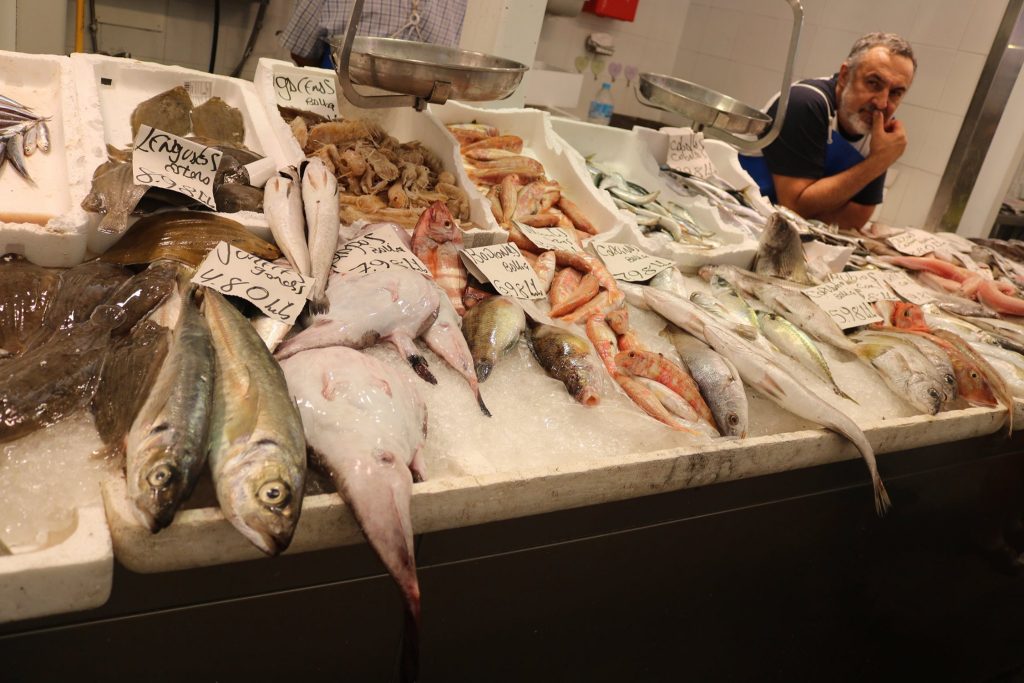Over the summer, I travelled to Spain where I sampled the magnificent cuisine of its southerly nether regions. In this gastronomic instalment, I highlight the best food and drink that Cádiz has to offer, followed by an impromptu recipe, paying homage to this region’s delightful flavours. But before I delve into the food, permit me please to muse upon the state of British tourism in Spain. We’re all too familiar with the overly commercialised fun-in-the-sun hotspots in Spain, frequented by those who more often than not completely overlook the local culture. Places like the Costa del Sol and Benidorm are excellent destinations for obsessive sun-worshippers seeking to perfect their tan. But I find that any semblance of the fishing villages that once formed a part of this majestic Mediterranean coastline is long gone from existence; and with that, a small bit of Britain has been recreated into the fabric of these areas by those who have absolutely no desire for cultural immersion.
And that’s the irony of it; these places have become a victim of their own success and I find myself frustrated whenever taking on a quest to discover great food which is almost next to impossible in these all-too-obvious destinations. Any local charm, any iota of character, any sense of heritage in such places has been mostly removed and replaced with urban apartment blocks, golf courses, Center Parcs replicas, and ridiculously over-priced restaurants that serve unappetising food, leaving little excitement in the palate, tranquillising curiosity, dissipating the senses, and ultimately only ever pleasing those who need a quick UV fix. Nevertheless, these epicentres of merchandising congestion still manage to fill their sandy shores with a large expatriate community who refuse to leave their own culture, but who will gladly leave their weather behind.
No. I would not fall for these Spanish tourist-traps nor venture down that rabbit hole of tacky nightclubs, anglicised food, and predictable fads and gimmicks. But where? Nothing too obvious, something with character, somewhere where I could soak in some history and architecture, and of course a place that offers heaps of delectable treats, along with doses of cultural aperitifs to wash down that tasty goodness …
And so the idea of going to Cádiz was inscribed into my imagination when I stumbled across a programme by Rick Stein called Rick Stein’s Long Weekends. His blend of homespun cooking and unpretentious bluntness, coupled with his joie de vivre charm left an indelible belief in me of the intrinsic link between food and the human condition. What better way into a country’s psyche than through its food and drink? Rick manages to combine food and culture in his shows so brilliantly in a way that is not wholly condescending but instead rather enlightening. His maxim of embracing culture, eating good food, and enjoying life is plain and simple truth. With beautiful romantic vignettes on the landscape, moments of literary eloquence, and reminders of the historical context of a particular dish, Rick makes us understand and see the hidden bits of the world through food. I’ve been watching Rick cook since I was young and I’ve read many of his books including the one which provided the name of this television series. I highly recommend this book which outlines all the recipes he recreates on the show. With this, I had a great culinary itinerary I could undertake on my journey.
I began my long weekend away by flying into Jerez Airport – just a few miles away from the city of Jerez de la Frontera – and was greeted by the sight of aged oaken barrels filled with sherry. Travelling further down south, I approached Cádiz and started to feel the salty air entering my tired lungs. I breathed and time seemed to pause as the city’s majestic towers, decorated with their pearly specks of incandescent white, blurred into the topaz Atlantic, leaving behind some traces of memory upon the cobbled roads and sandy beaches. Everywhere you go, you are greeted with the people of the city who seem to slowly meander, as if not sick with a malady but with the monotony of their blissful existence.
Splendidly situated in a curved bay that stretches out into the Atlantic ocean, Cádiz is a low city in the autonomous community of Andalusia. In the Barrio del Populo, the oldest quarter of the city, you are faced with these long parallel streets that lead you into a maze of typically quaint Spanish architecture, dotted every now and then with cafés serving thick hot chocolate and churros. As you slowly amble aimlessly in the narrow alleys, you discover that there is life in the cool shade provided by the tall crumbling houses, houses whose close proximities enable their balconies to almost kiss one another. Walking further, you find scraps of fragmented stone belonging to a time when Cádiz was a Phoenician port, an abandoned Roman auditorium surreptitiously attached to the old Barrio, and old military paraphernalia hearkening back to when the city had to defend its strategic location against Dutch and British invaders. The crowning jewel in all this is that glorious cathedral that sits proudly on the peninsula, overlooking the white dilapidated buildings and gazing into the African light — the city is just barely miles away from Morocco. It honestly is a revelation.
Image Source: Johnny Ignacio
Needless to say, the food was even more of a revelation. With influences from Moorish culture, Andalusian gastronomy is deeply connected with raw ingredients from the Mediterranean land and sea. So deep is this affinity between food and people that eating out late at night is the preferred way for many Spaniards to spend their evenings. With so many cheap tapas bars, it seems like the perfect way to unwind after a busy day. In the newer quarters of this ancient city, restaurants are busy with incoming orders. My first stop for lunch was Freiduria Marisquería Las Flores 1. Freidurias are immensely popular establishments that are enjoyed by both locals and tourists, serving bites of fresh fried fish — the Spanish equivalent of a local chippy. I remember stopping at a tiny and quaint square and seeing a massive queue coming out from one of the shops. This was a good sign. I got a ticket number and waited. After waiting for an agonising 30 minutes, I finally got round to making my order of ‘un cuarto de kilo pescaditos de fritos por favor’, a quarter kilo of mixed fried fish, please. It was well worth the wait. What I had was delightful: bits of succulent flakes of white fish as well as squid and prawns, dusted in a light flour a la Andaluza, fried in olive oil until crispy and golden, finished with some freshly squeezed lemon juice, a perfectly seasoned and delicious appetiser.
Gambas fritas (fried shrimp), calamares (squid), chocos (cuttlefish), and puntillitas (baby squid). Image Source: Johnny Ignacio
It makes sense that the predominant source of food here is fish. After all, Cádiz lies low in the sea. Produce in the area is always fresh as boats lug in heaps of fish from the port. Fisherman survey their catch and the first buyers are normally those who supply restaurants in the area and people who run the central market. I visited the marketplace to see how the fish was distributed and handled. As sellers sang to the notes of the cathedral bells and a chorus of customers danced hurriedly, the market — with its rising Roman columns surrounding an open courtyard — reminded me of a bustling opera. I love visiting markets in foreign countries. Something about it makes me think back to an age when commercial shopping didn’t exist and there was more of an intimate relationship between buyer and seller. It gives me a sense of what produce is available and what’s popular. Seeing fresh produce always fills me with excitement.
Image Source: Johnny Ignacio
After a well-earned siesta, I went to a restaurant late in the evening which targeted younger and dapper crowds. A great tapas bar with a fantastic minimalist setting to sit and dine in, Ultramar&nos was an enjoyable affair. I remember sitting by an open window on the ground floor, watching people make their way across this square that had New World-esque trees. I first ordered a small platter of jamón Ibérico (Iberian ham) and olives which was an exquisite nibble. Iberian pigs are only ever found in Spain and their gamey quality makes for bold, distinctive flavours. As the evening breeze grew chillier, I ordered a stew of chorizo and chickpeas that had hints of saffron, a wonderful marriage of meat and vegetables as well as a reminder of Spain’s Moorish past and its connection with North African and Arabic cultrue. This was followed by swordfish with tomatoes, olives, and capers, dressed with a sherry reduction of olive oil and parsley; a very classic Mediterranean dish. The salty capers just work so well with the tanginess of the tomato and the ripeness of the olives. And of course, I finished with a nice glass of manzanilla. New establishments like these contrast sharply with the macho, Toreador-style bars in the city like the Casa Manteca. I didn’t have a chance to go into the Casa Manteca since it was teeming with customers. But passing its old-fashioned facade, I could smell the sweet lechon or suckling pig wafting its aroma from the bar as well as the embers from cigarette-butts rising into the night. The Spanish answer to pork crackling, lechon is a great nibble and the perfect accompaniment to a Cruzcampo beer.
My new-found love of sherry, made me embark on a tour of the ‘Sherry Triangle’ which consisted of the cities of Jerez de la Frontera, Sanlúcar de Barrameda, and El Puerto de Santa María. Of the three I visited, Jerez’s bodegas had the best sherries. But all had a shared characteristic: the smell. The first thing that hits you when you visit these bodegas is the pungent aroma emanating from the barrels. At first, the smell is rather unpleasant and quite discomforting but you become used to it, finally becoming obsessed with the lingering aged fruitiness of the sherry caskets. I sampled a dark amontillado sherry in one of El Tio Pepe’s bodegas in Jerez. This drink is immortalised in Edgar Allan Poe’s dark short story about Spanish revenge in ‘The Cask of Amontillado’. Sherries come in many different varieties and the sherries I tasted included (in order of degrees of lightness) manzanilla, amontillado, and oloroso. The light, dry, and crisp manzanilla was my favourite since it paired so well with the fish in the region.
Image Source: Johnny Ignacio
One of my fondest food memories comes from a lunch I had in Cádiz. Situated on a narrow alley and tucked out of sight from tourists, Taberna El Tio de la Tiza may not at first glance look like a top-tier restaurant, but don’t let appearances fool you. It’s a hidden gem! This small, family-run seafood establishment was fully booked for two days, a testament to the restaurant’s popularity. The Spanish just do fish well, and very simply too. Simplicity is absolutely key when it comes to good seafood. As long as the seafood is fresh, you’ll have a wonderful meal. Some of the best food doesn’t necessarily have to come from Michelin-starred restaurants and I always find it a great shame whenever tourists pay extortionate prices for some half-hearted, meagre paella. Spain isn’t just about paella. It’s always a good idea to conduct some research and background reading before you explore the different culinary avenues abroad and I find that some of the best food is sometimes lurking away from tourists. Image Source: Johnny Ignacio
Image Source: Johnny Ignacio
I started off with tortillitas de camarones or shrimp fritters which is a classic staple in Cádiz. This was followed by some fried calamari. I remember eating outside under the shade; the buildings were so close to each other that they afforded good cover from the sweltering sun. The restaurant was absolutely packed and hearing the hustle and bustle from waiters serving food and the lively chit-chat from the other customers made me feel reassured in a weird way. I love these kinds of settings. For my main, I had a grilled whole mackerel (head, bones, and all) accompanied by some onion, red and green bell peppers, and sweet ripe tomatoes. And that’s all you need really. For such a simple dish, it just tasted so good! My parents had swordfish and tuna steaks, and we shared a hearty bowl of steamed clams and prawns. What I loved most about the clams and prawns was the fact that the chefs used water from the sea in order to steam the shellfish. By the end of the meal we were completely stuffed and we washed down all that wondrousness with refreshing manzanilla. All this for well under €30 for mountains of food, whereas other restaurants will perhaps charge in excess of up to €60 for a small main between two.
Image Source: Johnny Ignacio
Upon returning to Wales, I wanted to make a dish that combined the flavours I encountered on my trip. So I took inspiration from a recipe by Rick Stein: sea bream baked with some bell peppers, onions, and tomatoes. I pre-heated the oven to about 180C and added sliced potatoes onto the baking tray for approximately 15 minutes. In a frying pan, I briefly sautéed the vegetables and added some garlic; I wasn’t looking to add too much colour. This was elevated to a whole new level when I added dry oloroso sherry into the mix. The fruitiness perfectly compliments the fish and adds a nice sweet flavour. I added the sea bream on top of the potatoes in the baking tray and placed the rest of the vegetables alongside leaving it to bake for another 20 minutes or so. I also added a touch of water to get some more sauce. Once finished, sprinkle with parsley and lemon.
Image Source: Johnny Ignacio
When Byron reached Cádiz in August 1809 as part of his Grand Tour around Europe, he quickly developed a new love for the remarkable city. Recounting his travels in Childe Harold’s Pilgrimage, a semi-autobiographical narrative epic which follows a young man disenchanted with a life of revelry and who consequently seeks meditative solace in foreign climes, Byron writes:
“But Cadiz, rising on the distant coast,
Calls forth a sweeter, though ignoble praise.
Ah, Vice! how soft are thy voluptuous ways!
While boyish blood is mantling, who can ‘scape
The fascination of thy magic gaze?”

